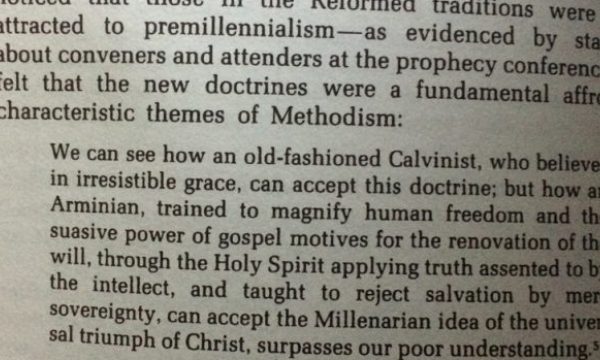Click to join the conversation with over 500,000 Pentecostal believers and scholars
Click to get our FREE MOBILE APP and stay connected
| PentecostalTheology.com



Scripture References:
Matthew 28:5-10; Luke 24:13-31; John 11:25, 20:11-18, 24-29; 1 Corinthians 15:1-8
When the Lord Jesus told Martha at the tomb of Lazarus, “I AM the Resurrection and the Life” (John 11:25, KJV), He proved it by bringing him back from the dead, doing so in public, giving further proof that He was who He claimed to be, God Incarnate.
He had raised others from the dead as a demonstration of His power and authority (Matthew 9:23-26; Mark 5:35-43; Luke 7:11-17, 8:49-56). Scripture tells of others who had been brought back to life by the power of God (1 Kings 17:22; 2 Kings 4:35, 13:21; Matthew 27:52; Acts 9:40). It is, however, the resurrection of the Lord Jesus Christ that became the doctrine of every apostle, the faith of every authentic follower of Christ, the source of the martyr’s courage, the theme of all authentic preaching (2 Timothy 4:1-5), and the power behind every evangelist who devotes themselves to the work of the LORD.
The physician and historian, Luke, the author of the Gospel bearing his name, as well as the Acts of the Apostles, wrote about the many “infallible proofs” of Jesus’ resurrection and appearances prior to His ascension back to heaven (Acts 1:3). This was the testimony of numerous eyewitnesses and was prophesied within the pages of the Old Testament of the Bible. The resurrection was foretold in the psalms of King David (Psalm 16:10, 11; Acts 13:34-35). It is the foundation of the Gospel, supplied by the entirety of the Godhead (Father, Son, and Holy Spirit), announced by Jesus Himself (Isaiah 53:10-12; Mark 9:9-10: John 2:19-22), and proclaimed by the apostles (Acts 2:24, 32, 3:15; Romans 8:11; 1 Corinthians 15:1, 4).
Scripture gives us the names and locations of where Jesus met with His followers after His resurrection. Mary Magdalene, the woman who had been delivered from demons was the first to see Him after He had risen (John 20:11-18). He also appeared to the women who were headed to the tomb to complete the ritual of anointing His body with burial spices (Matthew 28:5-10). He appeared to Peter and the disciples walking on the road to Emmaus (Luke 24:13-31, 34, 36-43). He appeared to His disciples when Thomas had returned to join them. His encounter with Jesus gave birth to the great words of faith and belief (John 20:24-29). Jesus appeared to the disciples who had been fishing all night (John 21:1-23).
The apostle Paul recorded that over five hundred brethren saw Jesus at one time (1 Corinthians 15:6). According to the law of Moses, only two or more witnesses were needed to verify a testimony (Deuteronomy 17:6, 19:5; 1 Timothy 5:19). Paul’s own testimony of being transformed from an enemy of Christ into one of His most faithful and active adherents is one of the signs of the validity of the resurrection by even the most skeptical of Bible scholars (Acts 9:1-6; 1 Corinthians 15:8). Jesus was also seen by His half-brother James after the resurrection, and he became the pastor of the church in Jerusalem (1 Corinthians 15:7). The Gospels record that none of Jesus’ brothers and sisters believed in Him until after He had been raised from the dead (John 7:5).
What of sources outside the Bible? Do they verify what has been written about the life and work of Jesus, specifically concerning His death and resurrection? In his book, I Don’t Have Enough Faith to be an Atheist, Dr. Frank Turek cites the work of Dr. Gary Habermas, who had collected over 1,400 of the most critically scholarly works dealing with the Resurrection from 1975-2003, found that across the theological spectrum from the most liberal to most conservative, all agreed that the following points concerning Jesus and Christianity are actual historical facts:
1) Jesus died by Roman crucifixion and was buried in a private tomb.
(2) Soon afterward, the disciples were discouraged, bereaved, and despondent, having lost all hope.
(3) Then, Jesus’ tomb was found empty shortly after His internment.
(4) The disciples all had experiences that they believed were actual appearances of the risen Jesus.
(5) Due to these experiences, the disciples’ lives were thoroughly transformed, even willing to die for their belief.
(6) The proclamation of the Resurrection took place early from the start of church history.
(7) The public testimony of the disciples and preaching of the Resurrection took place in the city of Jerusalem where Jesus had been crucified and buried shortly before.
(8) Sunday became the day of worship and gathering by the early Christians.
(9) As stated earlier, the conversions of Paul and James were cited as compelling evidence for the claims of the Resurrection of Jesus.
(10) Apostolic collaboration on the composition of the Gospels and the letters were all in agreement concerning the events of the Resurrection and the honesty of their testimonies. The Gospels present embarrassing details about their character and skepticism that would be missing if it were all a fabrication (Ex. Peter’s denial, the testimony of the women, Paul’s hatred of Christ prior to his conversion, etc.). (Source: Geisler, Norman, and Turek, Frank: I Don’t Have Enough Faith to be an Atheist; Wheaton, IL., Crossway Books, 2004, pp.299-300.)
In all things concerning Scripture and the claims of Jesus, do your own research and examination of the evidence. I want to give you a “starter list” of material to check for yourself and go from there:
The main takeaway is this: For over two thousand years, lives have been transformed and renewed by the fact that Jesus Christ is Lord and that He has been raised from the dead. If you are unsure about who Jesus is and what the deal is about the gift of salvation He freely offers to anyone who calls on Him, all you must do is ask Him (Matthew 11:28-30; John 14:6; Romans 10:9-10). I want you to be ready when that day arrives. Remember, without the fact of the Resurrection, any anticipation or hope for the Rapture and the promise of eternal life in the new heavens and earth wouldn’t exist. Thank you, Lord Jesus, that your promises are true and you are indeed returning soon. Glory to His name.
The post Resurrection of Jesus: What Does Scripture Say? :: By Dr. Donald Whitchard appeared first on Rapture Ready.



Anonymous
Crucified Friday, resurrected bodily on Sunday.
Anonymous
Some have argued that Arminianism offers little assurance that one will finally be saved due to the notion, which many Arminians hold, that a believer can lose his or her salvation. What may astound you is that Arminianism actually holds to a more firm case for the believer’s perseverance than does Calvinism.
First and foremost, a believer cannot lose his or her salvation (cf. John 3:16, 36; Rom. 5:1), since he or she by definition remains in the state of belief or trust in Christ and is hence a believer. The one who falls away from salvation is the one who is no longer believing or trusting in Christ alone and is thus not a believer. Second, the believer does not lose his or her salvation by falling into sin. Though sin may lead one to deny Christ, the act of sin itself does not cause one to lose his or her salvation. A person is justified by faith in Christ (Rom. 5:1). And a person is not justified due to unbelief. If a person no longer believes in or trusts in Christ Jesus for salvation, then that person will not be justified by God — accounted righteous in Christ and by His merit.